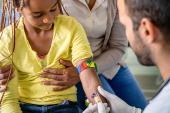SI! School Program: No Improvements in Adolescent CV Health
The setback isn’t an excuse to give up on public health initiatives aimed at preventing CVD in young people, experts say.

A school-based program aimed at promoting lifelong cardiovascular health for adolescents failed to make a dent, at least in its current iteration, newly published data show.
But despite the lack of impact, it’s important to persist in public health efforts aimed at primordial prevention, said lead author Gloria Santos-Beneit, PhD (Foundation for Science, Health and Education, Barcelona, Spain, and the Icahn School of Medicine at Mount Sinai, New York, NY).
“Even if we aren’t getting the result we wish to have, we have to keep working on it, because it’s the only way to change [the trajectory],” she told TCTMD. “We know that adolescence is a very critical period of time. Adolescents start making decisions about their leisure time, for example: if they play sports, if they go to the bar. These kinds of decisions are key for their adulthood.”
Schools helpfully offer access to a broad swath of individuals, not just the people who are seeking healthcare, Santos-Beneit added.
“Don’t give up. We are not getting a statistically significant difference, but we are still doing [good] things,” she emphasized. For example, Santos-Beneit said, the program planted a seed by making students more aware of their own habits.
The SI! Program, started by senior study author Valentín Fuster, MD, PhD (Icahn School of Medicine at Mount Sinai), was designed by the SHE Foundation in collaboration with the Spanish National Center for Cardiovascular Research. Its content not only touches on things such as diet and physical activity, but also covers self-esteem, assertiveness, and other emotion-management strategies to help students avoid harmful behaviors like tobacco use. It aligns with the school curriculum across various stages from preschool to secondary school.
Some Benefit at 2 Years
As reported recently in JAMA Cardiology, the SI! Program for Secondary Schools was conducted at 24 secondary schools in Barcelona and Madrid over a 4-year period between 2017 and 2021. Researchers randomized the participating schools 1:1:1 to a long-term intervention for 4 years (n = 412 adolescents), a short-term intervention for 2 years (n = 504 adolescents), or the standard curriculum (n = 441 adolescents). The two interventions had similar content, but with the 4-year program the information was distributed over a longer period of time and required fewer hours per academic year.
Mean age of the students was 12.5 years at the time of recruitment, and 51.6% were boys. Nearly nine in 10 students (86.0%) completed the entire study.
Cardiovascular health (CVH) was categorized on a scale of 0 to 14, with a higher score indicating better health, based on seven metrics recommended by the American Heart Association: smoking status, body mass index, physical activity, diet, blood pressure, total cholesterol, and blood glucose. At baseline, the mean overall CVH scores were 10.3 in the 4-year group, 10.6 in the 2-year group, and 10.5 in controls.
Don’t give up. We are not getting a statistically significant difference, but we are still doing [good] things. Gloria Santos-Beneit
Two years into the program, the mean CVH score had risen by 0.44 points more in students receiving the long-term, 4-year intervention than in controls (P = 0.04). For the short-term intervention, which was wrapping up at the 2-year time point, there was no significant difference compared with controls.
By 4 years, neither the long-term intervention, which was just ending, nor the short-term intervention held a significant advantage over the standard curriculum. However, there also appeared to be no adverse impact.
The encouraging signs seen early on at the 2-year mark were quite likely derailed afterward by the COVID-19 pandemic, said Santos-Beneit, though the extent of the impact is impossible to measure. During this time, in-person schooling was interrupted and the intervention, known as the SI! Program, was adapted to remote learning.
‘Persist in the Quest’
Holly C. Gooding, MD, and Liliana Aguayo, PhD, MPH (both from Emory University, Atlanta, GA), agree in an accompanying editorial that even though it’s disappointing to see such lack of improvement, “it is important to remember that even small changes in CVH or a slowing of CVH decline with age can translate into fewer CVD events later in life.”
Thus, they continue, “it is critical that we persist in the quest to improve the cardiovascular health of children and adolescents.”
Moving forward, it will be necessary to better understand what motivates teachers and adolescents as well as what needs and implementation barriers exist. To be successful, however, interventions will need to move beyond things like the school environment and what’s on the menu at home, they say. “Policies that support equitable access to higher education, quality housing, and employment, and that use incentives to regulate the production and purchase of unhealthy food and tobacco products, are needed to make ‘the healthy choice the easy choice.’”
A comprehensive message must reach “where people learn, live, work, and play,” the editorialists stress.
Santos-Beneit noted that interventions also must be tailored to age. The SI! Program previously has been done in preschool students, who are ready to absorb messages encouraging healthy decisions but don’t necessarily have the autonomy to make those choices. Adolescents are at an age where they have more power to control their diets, physical activity, and behaviors, she pointed out.
Up next, the research team will be focusing on the elementary-school level with an intervention that includes both classroom instruction and the overall school environment, said Santos-Beneit. At this age, she added, kids are starting to be more independent but don’t yet have entrenched habits.
Caitlin E. Cox is News Editor of TCTMD and Associate Director, Editorial Content at the Cardiovascular Research Foundation. She produces the…
Read Full BioSources
Santos-Beneit G, Fernández-Alvira JM, Tresserra-Rimbau A, et al. School-based cardiovascular health promotion in adolescents: a cluster randomized clinical trial. JAMA Cardiol. 2023;Epub ahead of print.
Gooding HC, Aguayo L. Hard lessons from a school-based intervention to improve cardiovascular health in adolescence. JAMA Cardiol. 2023;Epub ahead of print.
Disclosures
- The study was supported by the SHE Foundation-la Caixa Foundation and the Fundació la Marató de TV3.
- Santos-Beneit reports no relevant conflicts of interest.
- Gooding reports receiving grants from the National Heart, Lung, and Blood Institute outside the submitted work.
- Aguayo reports receiving grants from the American Heart Association and the National Institute of Environmental Health Sciences during the conduct of the study.





Comments